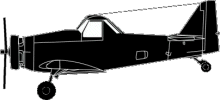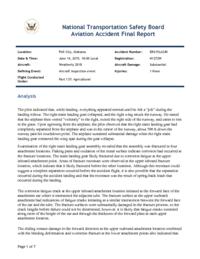
ASN Wikibase Occurrence # 290993
This information is added by users of ASN. Neither ASN nor the Flight Safety Foundation are responsible for the completeness or correctness of this information.
If you feel this information is incomplete or incorrect, you can submit corrected information.
| Date: | Sunday 14 June 2015 |
| Time: | 10:00 LT |
| Type: |  Weatherly 201B |
| Owner/operator: | Cobb Aerial Solutions LLC |
| Registration: | N1272W |
| MSN: | 627 |
| Year of manufacture: | 1974 |
| Total airframe hrs: | 4782 hours |
| Engine model: | Pratt & Whitney R-985-AN1 4B |
| Fatalities: | Fatalities: 0 / Occupants: 1 |
| Aircraft damage: | Substantial |
| Category: | Accident |
| Location: | Pell City, Alabama -
 United States of America United States of America
|
| Phase: | Landing |
| Nature: | Agricultural |
| Departure airport: | Pell City-St. Clair County Airport, AL (PLR/KPLR) |
| Pell City, AL | |
| Investigating agency: | NTSB |
| Confidence Rating: |
The pilot indicated that, while landing, everything appeared normal until he felt a 'jolt†during the landing rollout. The right main landing gear collapsed, and the right wing struck the runway. He stated that the airplane then veered "violently" to the right, exited the right side of the runway, and came to rest in the grass. Upon egressing from the airplane, the pilot observed that the right main landing gear had completely separated from the airplane and was in the center of the runway, about 500 ft down the runway past his touchdown point. The airplane sustained substantial damage when the right main landing gear contacted the wing spar during the gear collapse.
Examination of the right main landing gear assembly revealed that the assembly was fractured in four attachment locations. Flaking paint and oxidation of the metal surface indicate corrosion had occurred at the fracture locations. The main landing gear likely fractured due to corrosion fatigue at the upper inboard attachment point. Areas of fracture recontact were observed at the upper inboard fracture location, which indicate that it likely fractured before the other locations. Although this recontact could suggest a complete separation occurred before the accident flight, it is also possible that the separation occurred during the accident landing and that the recontact was the result of spring-back loads that occurred during the landing.
The corrosion fatigue crack at the upper inboard attachment location initiated at the forward face of the attachment ear where it intersected the adjacent tube. The fracture surface at the upper outboard attachment had indications of fatigue cracks initiating at a similar intersection between the forward face of the ear and the tube. The fracture surfaces were substantially damaged in the fracture process, so the crack lengths before failure could not be determined; however, it is likely that fatigue cracks extended along most of the height of the ear and through the thickness of the forward plate at each upper attachment location.
The sliding contact damage in the forward direction at the upper outboard attachment location combined with the bending deformation and overstress fracture at the lower attachment points also indicated that the fracture occurred at the upper attachment locations before the lower attachment locations. After separation at the upper attachment locations, the upper end displaced forward due to drag loads at the lower end, effectively rotating the assembly about the lower attachment locations, which resulted in secondary overstress fractures due to bending loads at the lower attachment points.
Preexisting cracks were also observed on the lower sides of the lower attachments. However, the fracture surfaces for those areas were damaged because they were on the compression side of the fracture. The cracks did not contribute to the separation because they were on the compression side of a bending fracture.
The airplane's most recent annual inspection was completed 25 days before the accident. The poor condition of the landing gear should have been noticeable and detected because inspections for the landing gear should have included the lower side of the lower attachments as well as the entire upper attachment area and the areas where the ears intersected the tubes.
Probable Cause: The inadequate inspection of the airplane's landing gear, which resulted in a collapse of the right main landing gear due to cracking and corrosion.
Accident investigation:
 |
|
Sources:
NTSB ERA15LA240
Location
Revision history:
| Date/time | Contributor | Updates |
|---|---|---|
| 07-Oct-2022 08:12 | ASN Update Bot | Added |
Corrections or additions? ... Edit this accident description
The Aviation Safety Network is an exclusive service provided by:


 ©2024 Flight Safety Foundation
©2024 Flight Safety Foundation